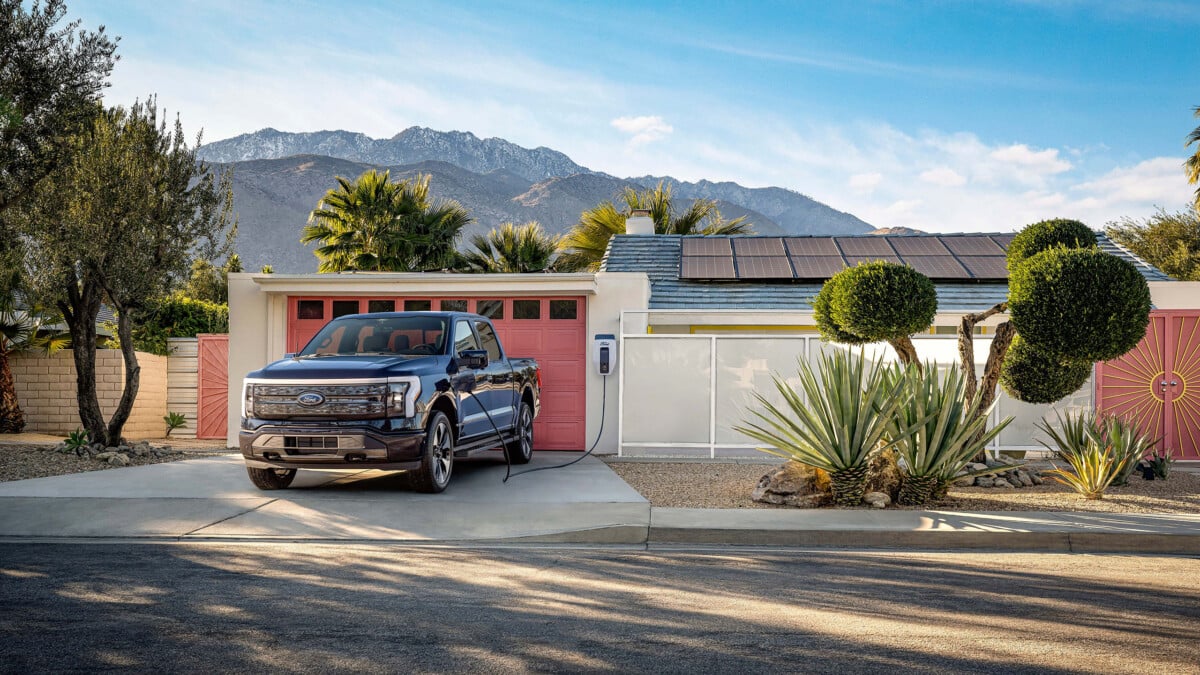[ad_1]
Or how the archetype of the American collector can advantageously replace domestic batteries for those seeking energy independence.

” Don’t buy a Tesla Powerwall, buy a turntable! This is the title of a video from the YouTube channel. Engineering Descriptionwhich – not without irony, and not without foundation – argues that it is better to buy a Ford F-150 Lightning to power your home than a Tesla Powerwall.
In reality, buying an electric vehicle for bidirectional power functionality in the first place will only make sense in extremely rare cases, as the video shows. Still, it gives those who dream of energy independence the opportunity to revisit a few orders of magnitude.
Best cost per kilowatt hour on the market
So we discover that the utility version of the Ford F-150 Lightning is by far the lowest cost per kilowatt hour electric vehicle on the market at $425/kWh. “Worse”, it costs less than a Tesla Powerwall ($778 to $556/kWh depending on the number of units, taking into account declining rates).
Sold for $10,500 per unit and $7,500 for four units, the Tesla Powerwall, as a reminder, is a domestic battery with a capacity of 14 kWh (including 13.5 kWh useful). It can be used as an emergency power source in areas with power outages or as photovoltaic solar panels storage for nighttime supply of energy stored during the day.
| net capacity | Prices starting from | price/kWh | |
|---|---|---|---|
| Ford F-150 Lightning Pro Standard Series | 98kWh | $41.669 | $425 |
| Chevrolet Bolt EV | 65 kWh | $31.995 | $492 |
| Volkswagen ID.4 | 82 kWh | $41.955 | 512$ |
| Tesla Power wall | 13.5 kWh | $7,500 | $536 |
| Nissan Leaf | 62 kWh | $33.425 | $539 |
| Rivian R1T | 135 kWh | $74,075 | $549$ |
| Hyundai Kona EV | 64kWh | $35,185 | 550 dollars |
| Dacia Spring | 27 kWh | 17,390 € | 635 € |
| Tesla Model 3 Long Range | 82 kWh | $52,490 | $640 |
Two-way charging all the way
Some electric vehicles have offered “two-way charging” since at least the 1st generation of the Nissan Leaf in 2010. Some models, such as the Hyundai Ioniq 5 or Kia EV6, are thereforefrom vehicle to loading or V2L) or another electric vehicle (vehicle to vehicle or V2V). Some manufacturers, such as Nissan, offer to inject electricity into the grid to streamline production (vehicle to network or V2G) can prevent starting to pollute power plants in the event of a consumption peak.
And some, like the Ford F-150 Lightning, offer to power a home like a household battery. In addition to 10 household sockets for V2L and V2V applications, this commercial vehicle from vehicle to home (V2H). Combined with the Ford Charge Station Pro charging station, it restores 98 or 131 kWh of its battery (Standard or Extended Range versions) to power the average American home (30 kWh/day) for 3 to 4 days.


Electric car instead of domestic battery
Ford presents the virtues of this solution, called Intelligent Backup Power, in a press release. Compared to a diesel generator, this solution is quieter and less polluting. Engineering Description calculated that such a generator emits about 275 kg of CO2 per day. And one report found that the carbon footprint of a 78 kWh battery in a Volvo XC40 Recharge is about 7 tons of CO2, equivalent to 25 days of generator use.
The manufacturer also boasts of the lower cost of its solution compared to domestic batteries. Engineering Description He calculated that the 94.5 kWh Tesla Powerwall costs $52,500 (7 units of 13.5 kWh), but we can also calculate that it pays $45,000 for 81 kWh (6 units). $41,669 at Ford pays for 98 kWh… AND a pickup!

Admittedly, you rarely need a battery backup for 3 to 4 days in a row. And certainly, a household battery has its advantages, starting with not having to choose between powering your home or going to work with your turntable. It is no less surprising to learn that an entire receiver is cheaper than an equivalent capacity of dedicated domestic batteries, and these technologies vehicle increasingly for homeowners the energy transition will be a welcome bonus (from vehicle to home)… even a benefit to society (vehicle to network)!
https://www.youtube.com/watch?v=oc3sQ2UcTlg
We invite you to download our Android and iOS app to follow us. You can read our articles, files and watch our latest YouTube videos.
[ad_2]
Source link